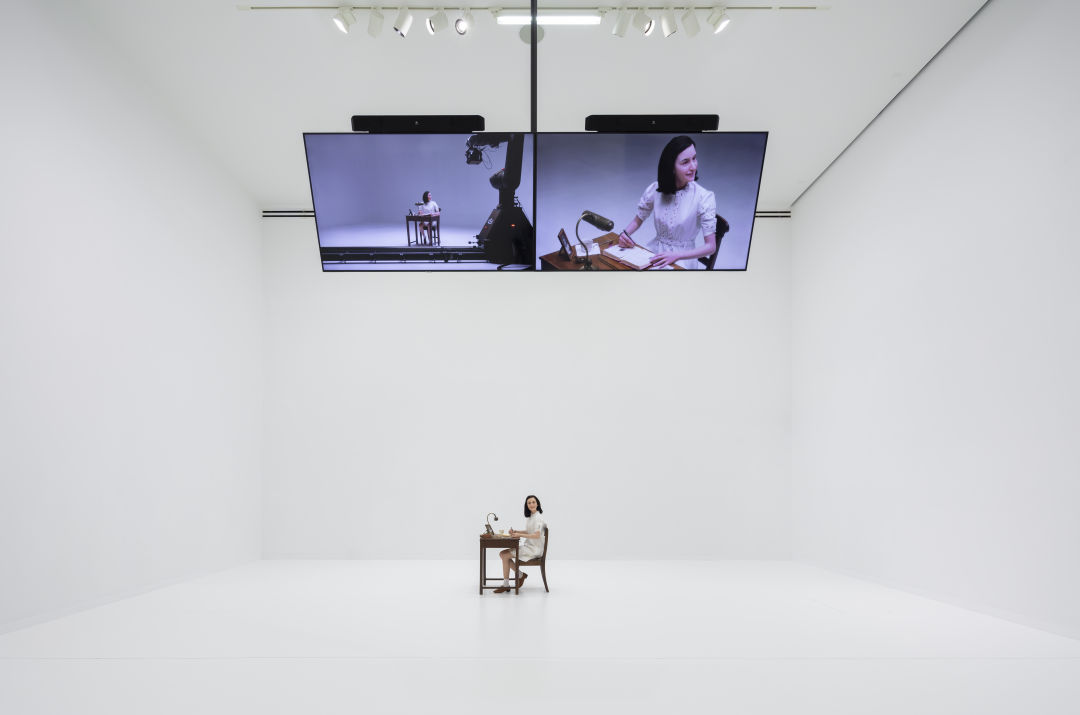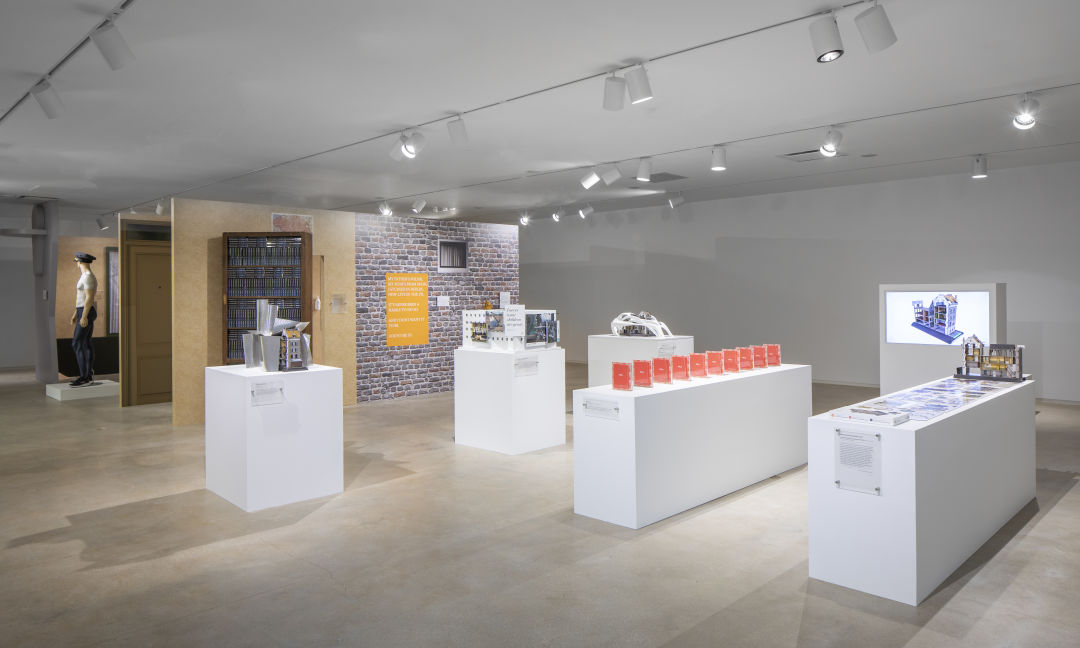Explore Capitalism and Memory in the Anne Frank-Inspired Hope House

"Likeness" at Blaffer Art Museum's Hope House exhibition.
Updated 4:45 p.m. Jan 25
In his own telling, Simon Fujiwara never thought he would work with the legacy of Anne Frank. After all, the inquisitive British-Japanese visual artist has no “personal history” related to the Holocaust, and past works, such as Welcome to the Hotel Munber (2006) and Rehearsal for a Reunion (with the Father of Pottery) (2011-2012), tend toward intimate autobiographical themes. But perhaps that is one of the many lessons proffered by the Berlin-based artist’s first installation in Houston: In this age of capitalism and free information, all are invited to participate in the sacred act of memorialization.
Determining precisely what this means is the subject of Fujiwara’s Hope House, on display at the Blaffer Art Museum through March 14, an ambitious exhibition inspired by a 2017 visit to the Anne Frank House in Amsterdam. The canal-side memorial museum, which was founded in 1957 with the goal of “bring[ing] the life story and the work of Anne Frank to the attention of as many people as possible worldwide,” captivated Fujiwara in content as much as execution. Museum visitors are invited into the original, albeit renovated, house where the young Jewish diarist and her family avoided persecution before their eventual arrest, imprisonment, and deaths in Nazi concentration camps. In the secret annex, a cramped hideaway where Frank and others spent two years in hiding, visitors can observe photographs and postcards a young Frank pasted to the walls. In the diary room, they see the original, red-checkered diary Frank filled with her now-famous entries and stories.
If the planetary draw of this intimate, almost invasive, museum experience merely intrigued Fujiwara, it was the museum’s gift shop that earned the artist’s full attention. The shop, which offers replica diaries and cardboard models of the house for sale, “made me immediately uncomfortable,” he recalled in a Blaffer Art Museum forum. “What on earth would I write in this diary that could ever match the historic gravity of what Anne Frank was going through?” It struck him as a superfluous, if not tawdry, manner of communicating the tragedies of the Holocaust—and yet, there was clearly a demand for such products, for the museum chose to market the product to the million-plus visitors it draws annually (pandemic years aside).

Hope House at Blaffer Art Museum.
Bewildered, he launched a full-scale study into how institutions seek relevancy within the confines of capitalism and self-interest. “It’s a great big mess, it was a big tangle for me, so I thought, why not build it? Why not remake it, and talk about this tangle and this mess?”
And build it he did. Hope House is a re-creation of a floor of the Anne Frank House, which Fujiwara has repopulated with an array of objects that confront modern museum practices and consumer-driven philanthropy. Hung on the dollhouse-like walls is everything from a pair of tickets to the Apartheid Museum in South Africa, where visitors are provided with randomly generated racial designations that determine their museum experiences, to a menu from The Clink, a British charitable initiative that invites the public behind prison walls to eat gourmet meals prepared by inmates in culinary training. While both institutions are well-regarded, one is left to wonder if the promise of participation is the only method of encouraging good will and growth.
Other objects more directly reference the Anne Frank House’s complicated crossover between solemn memorial and marketable enterprise. In “Diary,” Fujiwara neatly displays 10 replica copies of the aforementioned Anne Frank diary as if they were meant for careful, anthropological regard, or for sale at a luxury retail store. “Untitled (Extension)” consists of a cardboard model house—another gift shop purchase—partially concealed beneath an undulating metal structure reminiscent of Bilbao’s Guggenheim Museum.
The cornerstone of the exhibition, titled “Likeness,” is a wax figure of Anne Frank seated at a wooden desk in the middle of a vast, white room. Poised with a pen, she smiles toward the viewing area, which is some dozen yards away and separated by a metal rail. Two television screens looping close-detail footage of the wax Frank and the contents of her desk traverse the distance for us; Frank is far away, but via the television screens, we can see the contours of her face, the portrait on her desk, and the careful, handwritten entries in her diary. The juxtaposition of technological proximity and physical distance locates another thesis of Fujiwara’s exhibition: that the rise of technology has presented new opportunities and challenges for museums and artists alike.
Fujiwara is handling delicate material in this exhibition. Executed poorly, Hope House could be viewed as a mockery of the Anne Frank House, a cynical repudiation of commercialized grief in the museum industry. But for as much as Fujiwara is discomforted by the marriage of memorial and product—“Why should I have the experience of putting Anne Frank’s bedroom wall into place?” he asked earnestly, referring to the cardboard model houses—he participates himself, effectively acknowledging the uncomfortable complexities of memorialization in the modern era. Consequently, Hope House is an anthropological study and a conversation-starter; it is a series of free-response questions appended to a catalogue of human attempts to navigate a world with a long history of tragedy. At the Blaffer panel discussion, a panelist asked Fujiwara what he made of the term “problematize.” The artist looked surprised, then smiled wryly. “I love problems. They’re the truth, aren’t they?” Hope House presents several such problems to its audience; in contemplating them, visitors confront the truths about themselves.
Thru Mar 14. Hours: noon to 5 p.m. Wednesday–Sunday. Free, reservations only. Blaffer Art Museum, 4173 Elgin St. More at blafferartmuseum.org.




